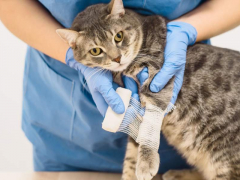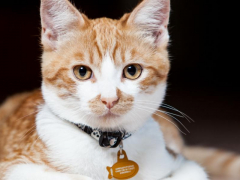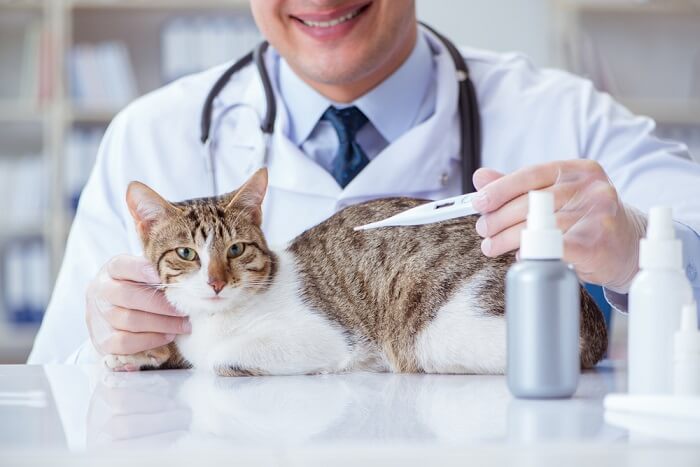
You can easily measure your cat’s body temperature, something that can provide important information about a cat’s wellness or otherwise. Body temperature is one of the key vital signs of a cat’s health, alongside heart rate and breathing rate.
How Do Cats Regulate Their Body Temperature
The natural physiology of a cat’s body acts to ensure that the temperature range stays at the normal level all the time. The temperature only changes from the normal level due to specific circumstances, such as disease or stress.
- When a cat is resting, the baseline body temperature tends to be low, as the body is inactive.
- When a cat becomes active or stressed, the body temperature may rise slightly, usually along with the breathing rate and heart rate.
Added to this physiological variation, if a cat is suffering from various diseases, the body temperature can be significantly higher or lower.
Monitoring your own cat’s body temperature can be a useful way of checking on its general health. If you record a cat’s vital signs regularly, it can be helpful for your veterinarian. In an emergency situation, it can be useful to measure the body temperature as a way of explaining in more detail to your veterinarian what’s going on with your pet.
The Normal Body Temperature of Cats
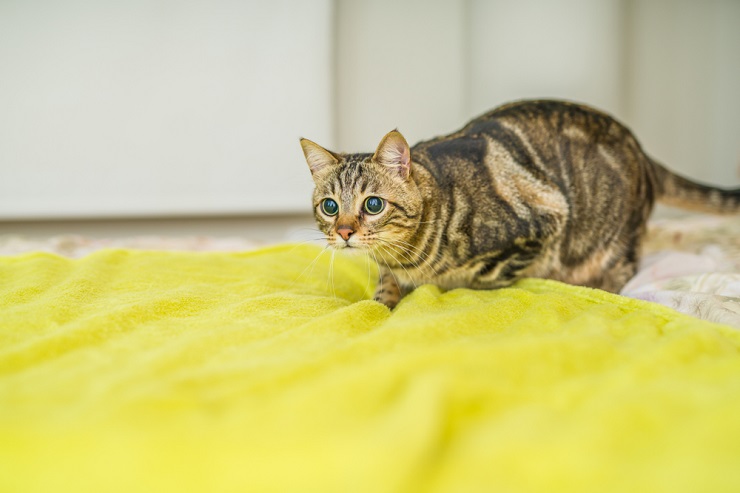
The body temperature is measured in degrees Fahrenheit or in degrees centigrade (Celsius). This is written as degrees F or degrees C. Fahrenheit is used most commonly in the United States; in Europe and many other countries, centigrade is more likely to be used.
The cat’s normal body temperature tends to stay within relatively narrow parameters.
- Normal range of temperature is between 101 F and 102.5 F (38.3 C to 39.2 C)
- If the temperature is below 100 F (37.8 C), it’s too low
- If the temperature is over 103 F (39.4 C), it’s too high
These temperature levels are not absolute, but they provide a helpful general guide.
How to Measure Cat Body Temperature
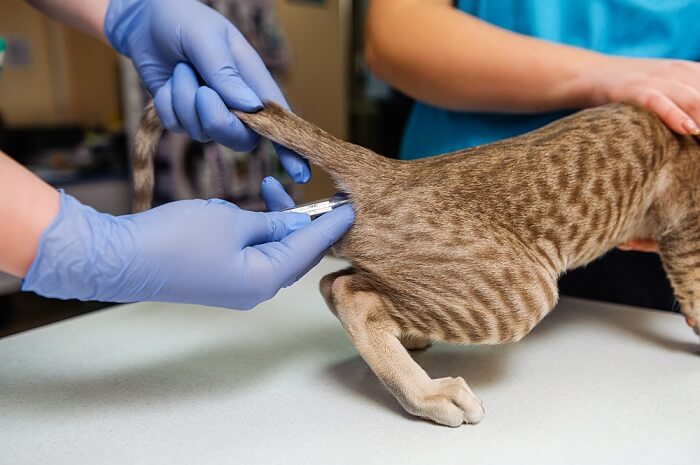
To take your cat’s temperature, gently inset a lubricated thermometer about 1 to 1.5 inches into the rectum.
Taking a cat’s temperature is easy to do, and this a helpful skill for all cat owners to learn. Here’s how to safely and accurately take your cat’s temperature:
- Use a digital rectal thermometer. These are inexpensive and widely available.
- Lubricate the tip of the digital thermometer using soap, petroleum jelly or a lubricant gel.
- Do not push hard. If the thermometer does not go in easily, do not persist.
- Insert the thermometer via the anus into the rectum about 2 to 3 centimeters (about 1 to 1.5 inches).
- Hold the thermometer in place until it beeps, or for around one minute.
- Take the reading and write it down.
Special ear thermometers which take a reading from a cat’s ear are available, but they are not as effective or trustworthy as rectal thermometers.
Causes of Abnormal Body Temperature in Cats
There are many possible causes of abnormalities in the body temperature.
Cat’s Body Temperature Is Too Low
If a cat’s body temperature is less than 100 F (37.8 C), it’s too low. If you take your cat’s body temperature and it is this low, record the body temperature again 15 minutes later to ensure an accurate reading. If it is still low, book an urgent appointment with your veterinarian for a review.
Possible causes of low body temperature include general debilitation, serious illness, exposure to cold temperatures outside (e.g. in outdoor cats) and low blood glucose.
Cat’s Body Temperature Is Too High
If your pet’s body temperature is over 103 F (39.4 C), it’s too high. Again, to ensure the reading is accurate, record your cat’s body temperature again 15 minutes later. If it is still too high, book an appointment with your veterinarian for a review.
The most common reason for a high temperature is an immune system reaction that releases chemicals into the bloodstream that raise the temperature above normal.
Possible causes include viral or bacterial infections, neoplasia (cancer), and pain, as well as other medical conditions.
Higher temperatures can also be caused by excessive activity or exercise, and exposure to high environmental temperatures.
Finally, a specific condition known as “fever of unknown origin” (FUO) happens when no underlying cause of the high temperature can be identified for a cat’s fever.
Other Information From the Thermometer
It’s worth noting the appearance of the tip of the thermometer after removal from the rectum. There should be just a fine coating of feces, which you should wipe off with moist tissue or cotton.
Check for an increased level of “wetness,” which could indicate diarrhea, or any sign of blood or blackness (indicating digested blood), or excessive mucus, any of which could indicate some type of digestive disorder.
Recording Other Vital Signs
If the body temperature is too high or too low, it’s worth also assessing other aspects of your cat’s vital signs
- Count your cat’s respiratory rate (by measuring the number of breaths in 15 seconds, and multiplying by four).
- Measure your cat’s heart rate (by feeling it via the chest wall or taking a pulse, and measuring the number of beats in 15 seconds then multiplying by four).
You can then report all of your pet’s vital signs to your veterinarian: temperature, heart rate and breathing rate.
Treatment of Low or High Body Temperature in Cats
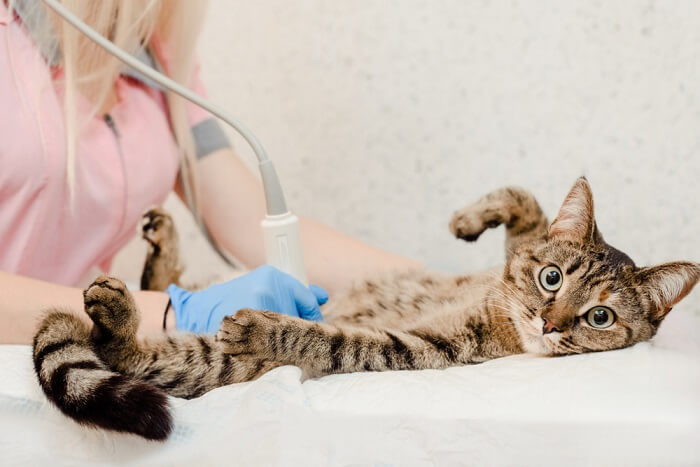
If your cat’s body temperature is too high or low, visit your veterinarian for further treatment.
Do not attempt to treat your cat’s low or high body temperature yourself. The use of human-type drugs such as acetaminophen (Tylenol) is dangerous in cats, and causes severe toxic reactions. Instead, take your cat to your local veterinarian.
The first thing your veterinarian will do is to check your cat’s body temperature and vital signs themselves, and carry out a detailed physical examination, checking for other signs of ill health such as weight loss.
If the veterinarian is concerned, he or she may recommend various investigations, such as blood and urine samples, x-rays (radiography), ultrasound and an EKG. A normal veterinary medicine work up will usually be undertaken.
This process should allow your veterinarian to identify the cause of your cat’s abnormal temperature, so the appropriate treatment can be given.
Treatment of Low Body Temperature in Cats
As well as treating the underlying cause, it’s important that a cat with a low body temperature is warmed up, either in a warm room, with heaters, or with careful use of heating pads or hot water bottles (being very careful not to burn the cat by keeping at least three layers of toweling between the hot water bottle and the cat’s body).
Treatment of High Body Temperature in Cats
Treatment of the underlying cause of a high body temperature may include antibiotics, anti-inflammatory medication and other drugs, depending on the specific problem. Heat stroke, caused by high environmental temperature, needs specific actions to be taken. Intravenous fluids may be given to cats with high temperatures to keep them well hydrated.
It’s easy to learn how to measure your pet’s temperature, and this can act as a useful additional guide to your pet’s health, as well as providing helpful information you can pass on to your veterinarian.
